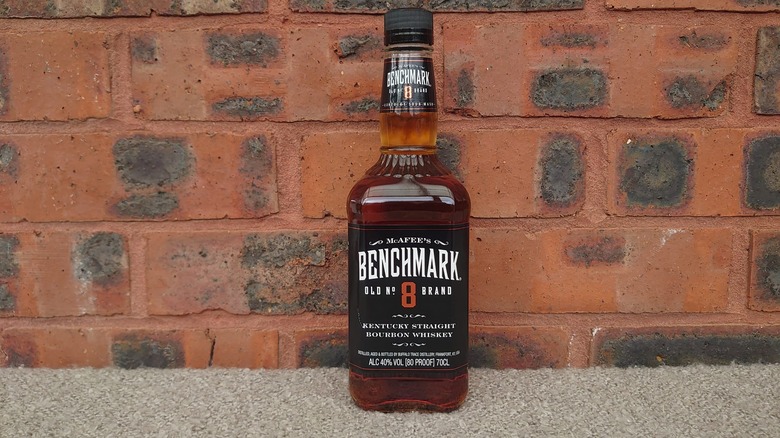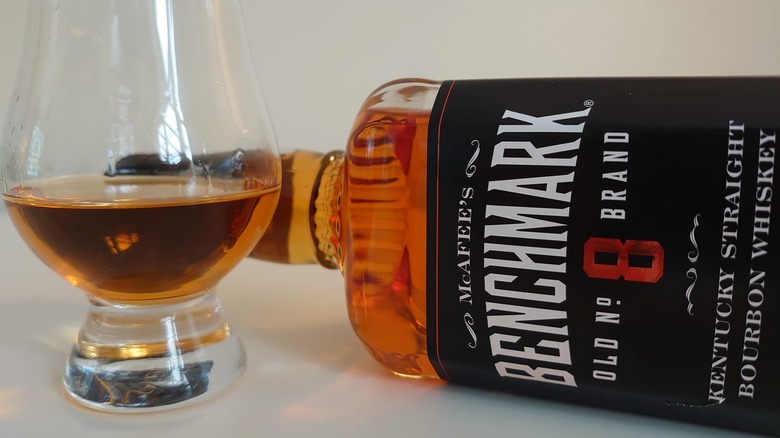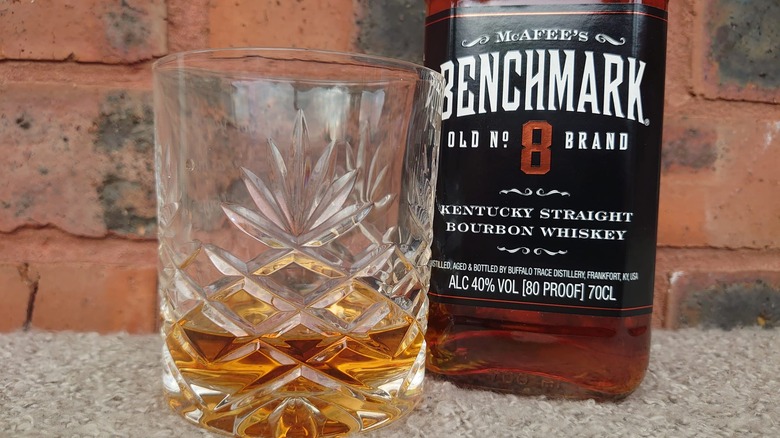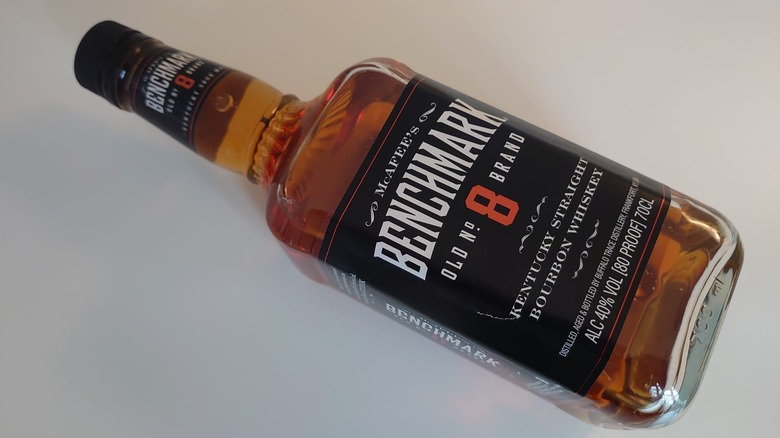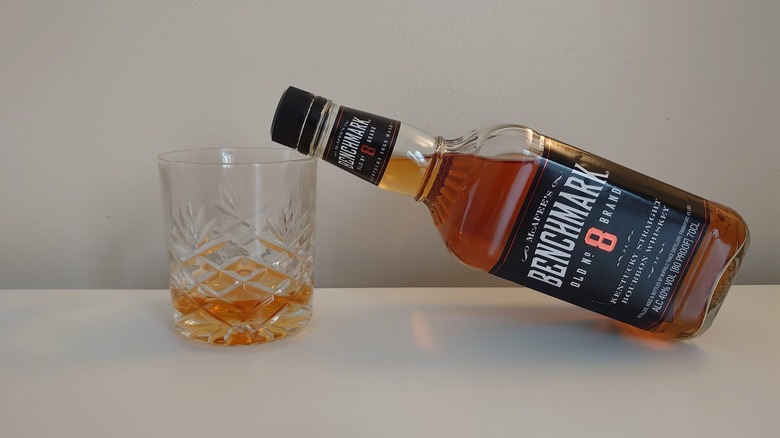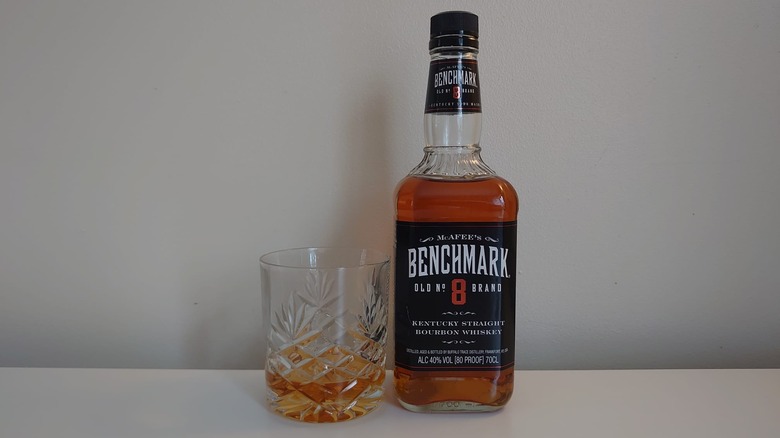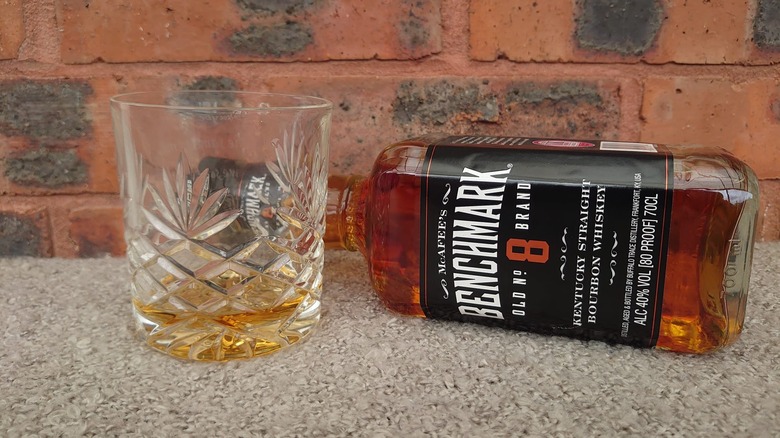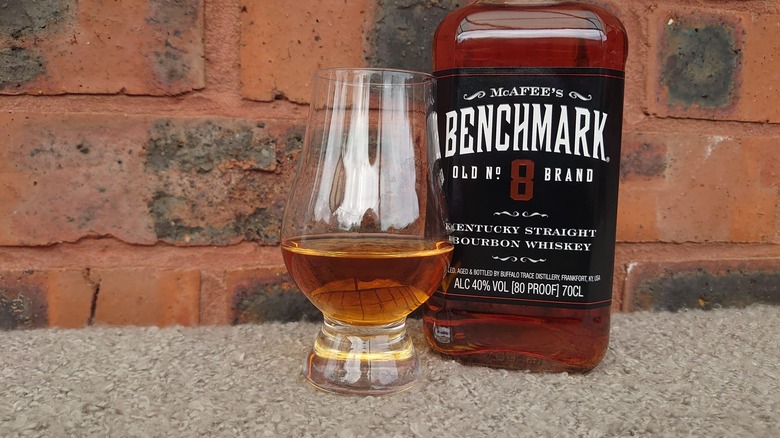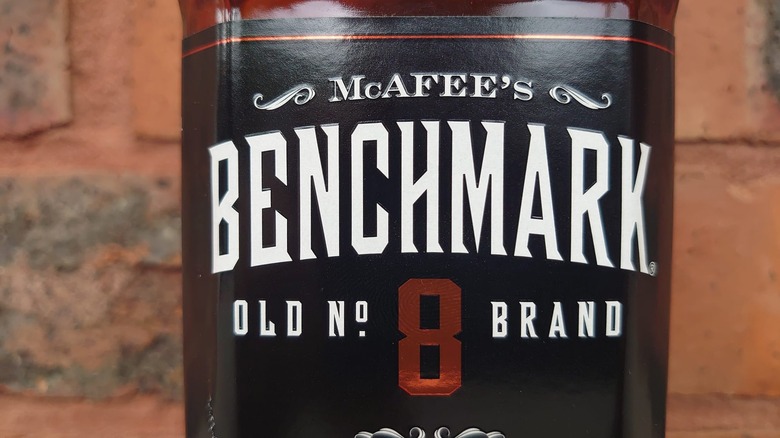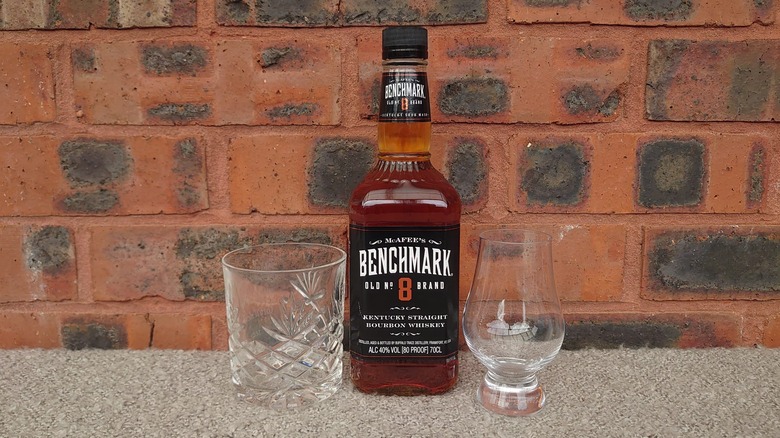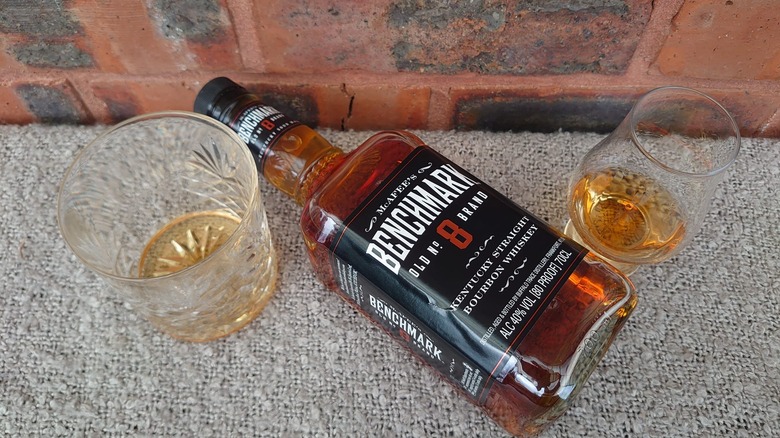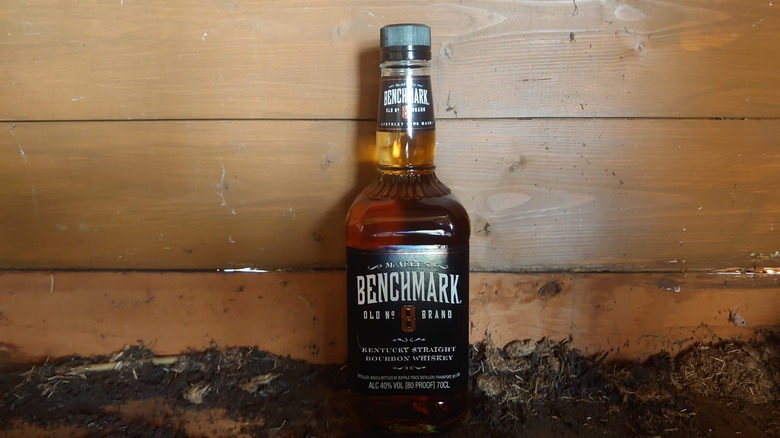Benchmark Bourbon Whiskey: The Ultimate Bottle Guide
The Benchmark brand has been on an interesting journey since its conception in the 1960s. First released as a premium brand, it's since become one of the better-tasting affordable bourbons you can buy. It may no longer be marketed as a top-shelf whiskey, but it's much-loved for delivering value without compromising on quality.
With a rich palate of vanilla and caramel, it offers subtle warmth and a satisfying finish. It generally comes at a fair price, too (though it has plenty of competition in that regard). Of course, if you're wondering whether you should buy a bottle of Benchmark or opt for one of its many rivals, it's helpful to know more about the bourbon and brand.
Having learned what separates the bad from the good — and the good from the great — through my many years enjoying (and writing about) whiskey, I'm more than capable of tackling this budget bourbon. While the Benchmark brand offers a range of expressions, I'll be focusing on its flagship Old No. 8 Kentucky Straight Bourbon in this article. With that in mind, join me as I guide you through everything you need to know about Benchmark Bourbon Whiskey.
Some recommendations are based on first-hand impressions of promotional materials and products provided by the manufacturer/distributor/etc.
History of Benchmark Bourbon
The history of Benchmark is intertwined with the story of Seagram's. Previously among the largest and most influential spirits companies in the world, the legacy of Seagram's can be traced back to 1857, though it didn't introduce the Benchmark brand until the mid-twentieth century. At first, Benchmark — minus the "McAfee's" name that would later be added to the label — was positioned as a premium bourbon. The liquor was initially made in Lawrenceburg, Kentucky under Seagram's, as well, at a distillery known as Old Prentice.
Seagram's interest in the brand floundered through the years, and it was sold to the Sazerac Company in 1989. Consequently, when Seagram's later imploded after its many expansion attempts failed spectacularly, Benchmark was already in the safe hands of a huge multinational spirits company in Sazerac.
Benchmark eventually moved its production premises to Frankfort, Kentucky, as it proudly states on the bottle (with Four Roses bourbon now being made at Benchmark's former home). Additionally, the whiskey was rebranded over time as a more affordable bourbon by Sazerac, with the McAfee name added later, as well. More than that, Sazerac is the owner of the Buffalo Trace distillery, which is where Benchmark found a permanent home for its whiskey production.
What does Benchmark Bourbon taste like?
The taste of Benchmark is fairly basic but it does have some interesting tasting notes. The nose is fairly pleasant, with the most dominant note being that of vanilla. There's also caramel there along with more muted tones of spice and plum. Upon tasting, there is a little initial harshness, but it's far from overwhelming. Once you let the drink settle into your mouth, a few nice flavors open up, and the caramel in particular is impressively deep.
The bourbon has a slightly dry mouthfeel at this point, as well — a feature more commonly associated with white or rosé wine. The most impressive part was the notable oak influence, which is less common in younger whiskeys. Given there's also a subtle tobacco influence, I'd say this bourbon is more suited to those who prefer earthier flavors. Another impressive aspect of the Old No. 8 bourbon is the satisfying finish. While no new flavors develop, there's no harshness, either, and you're left with a dry, spicy warmth.
Now, there may be better bourbons, but very few can be purchased at a similar price point. On that note, Benchmark succeeds where many other cheap bourbons fail. It offers an excellent balance between sweetness and warmth, and when I'm unable to get my hands on a more premium bottle? I'm happy to sip this whiskey all night long.
How is Benchmark bourbon made?
When making bourbon, you first need to decide on the mash bill (or the different ingredients used to produce the alcohol). The Buffalo Trace distillery likely uses four main mash bills, and like the flagship bottle of Buffalo Trace-branded bourbon, Benchmark appears to utilize the distillery's mash bill #1. Now, the exact makeup of this mash bill is a secret. However, it's seemingly low rye, doesn't use wheat, and likely has a very high percentage of corn — at least 51%, in fact, as is legally required of all bourbon.
Once selected, the grains are combined with limestone water to create the mash. The water plays a crucial role in the overall taste along with the grains, as does the proprietary yeast strain used for fermentation. After fermentation, the mash is then distilled in one of Buffalo Trace's huge copper column stills to concentrate the alcohol. As with all bourbon, it is then placed in new, charred American oak barrels to age, and it's from the wood where the whiskey gets much of its sweetness and spice.
Once it's aged, the distillery's master blenders will taste-test the whiskey, only giving the green light for bottling when it passes the quality check. After all, Benchmark may not be viewed on the same level as some of the more revered bourbons made at the Buffalo Trace distillery, but it still goes through the same quality checks.
How to drink Benchmark bourbon?
When drinking expensive bourbon, I always feel compelled to drink it neat. The spirit deserves to be savored, after all, and drinking it neat allows you to do just that. Now, Benchmark's affordability means you can feel comfortable enjoying it any way you like. But if you're on a budget and looking for a cheaper sipping bourbon, this can tick that box. In that sense, any decent bourbon should be easy to drink neat regardless of price, and Benchmark is no exception.
While it passes as a sipping bourbon, Benchmark can be enjoyed in many other ways, as well. The whiskey works well with your mixer of choice and also in a variety of cocktails. Classics such as the old fashioned or the Manhattan are served well by its robust flavor, giving them an added layer of complexity. If you want to enjoy it chilled, it's best to use a large ice sphere that melts slowly to maintain the flavor of the bourbon without watering it down too much.
Ultimately, Benchmark is a versatile bourbon that can be enjoyed whichever way you prefer. There may be better bourbons for drinking sans additional ingredients. But this whiskey allows you to enjoy an authentic-tasting bourbon — one with minimal harshness on the tongue and no bitter aftertaste — at an eminently affordable price.
Is Benchmark bourbon expensive?
Given what I've already mentioned thus far, you've likely made the wise assumption that the answer to this question is no. In fact, the average price for a standard 750-milliliter bottle of Benchmark Bourbon Whiskey is around $11 as of July 2024. At that price level, it's very difficult to find anything cheaper that tastes quite as good. Simply put, anyone on a budget who still wants the classic taste of bourbon will likely find Benchmark to be a great deal.
Despite its low price, Benchmark is worthy of consideration for both seasoned bourbon aficionados and newcomers to the spirit. It may not be the greatest bourbon out there, but it still offers value for money — and even tastes better than some bourbons that cost twice as much. Frankly, it's a solid bourbon option for anyone to have in their liquor cabinet given the price and flavor profile.
Plus, if you're looking for a whiskey to add to mixers, Benchmark is a better option than many other inexpensive brands. This may be, in part, because of its Kentucky straight bourbon designation, which is lacking with many other budget bourbon bottles. A whiskey can only be called "straight" bourbon if it's been matured for more than two years, after all, which sets Benchmark apart from other low-cost varieties.
Benchmark vs Benchmark Full Proof
There's a range of other expressions sold under the Benchmark banner beyond its standard bourbon. In fact, if you're looking for a little more power from your whiskey, Benchmark Full Proof is a great alternative. The "full proof" name is given to a whiskey if it's bottled at the same proof as it entered the barrel. This is different from barrel proof (and other types of bourbon), which is bottled at the proof that it leaves the barrel. Consequently, the Benchmark Full Proof comes in at 125 proof compared to 80 proof for the Old No. 8.
Now, we mentioned that Benchmark Old No. 8 Kentucky Straight Bourbon Whiskey is robust, but the Full Proof expression takes that to the next level. The flavors that we looked at earlier are amplified, which adds to its complexity. Along with the classic flavors of its lower-proof sibling, there's an extra spiciness along with some charming chocolate notes in the Full Proof option.
Choosing between these bourbons will largely depend on your personal taste. If you've never had high-proof whiskey before, it can be a little overwhelming at first as the alcohol is quite dominant. If you're used to powerful whiskeys, then Benchmark Full Proof will give you a better (and more potent) tasting experience. If you've never had either, though, I'd recommend starting with the Old No. 8 before moving on to other Benchmark offerings.
Benchmark vs Evan Williams
Evan Williams shares many similarities with Benchmark, making it a good comparison. Each bourbon offers decent value for the cost, comes in a classic black labeled bottle, and is quite underrated overall. They also come from huge distilleries, with Benchmark from Buffalo Trace and Evan Williams one of the many brands produced at the Heaven Hill Distillery.
There are a few key differences between these two whiskeys, though. Evan Williams has a slightly spicier flavor profile, for instance, and clocks in at a slightly higher 86 proof. You'll get a hit of pepper on the palate, as well, along with the classical bourbon notes of caramel, vanilla, and oak with this bourbon. Conversely, I'd say Benchmark has more of an oak influence overall.
In terms of pricing, Evan Williams may be a slightly more expensive option (with an average cost of $15 as of July 2024), though it's still highly affordable. It comes down to a simple case of preference, then. While I prefer Benchmark — I tend to like earthier bourbons that have more of an oak and char influence — if you like the classic bourbon taste with a little extra spice? Evan Williams may be the choice for you. In fact, if you've only tried one of these two, it's worth trying the other to see how they compare to your palate.
Who were the McAfee brothers?
At the top of the bottle, you'll see it described as "McAfee's Benchmark" — but who were the McAfees, and why is their name adorned on the label? Contrary to what you may think, the three brothers (James, George, and Robert) had nothing to do with making whiskey. Rather, they were early pioneers who left Virginia to explore what would eventually become Kentucky.
The McAfee brothers surveyed the land with the help of native trails and Buffalo tracks (which was what eventually led to the Buffalo Trace name). Of course, if these brothers had nothing to do with the bourbon, why is it called McAfee's Benchmark? The answer is that the "benchmark" aspect refers to something completely different. When exploring the territory, the McAfee brothers used so-called benchmarks to help guide them, which is anything that you can be used as a point of reference.
Therefore, the name refers to the supposed benchmarks left by the brothers during their journey, and this piece of Kentucky history was honored by Sazerac with the addition of the McAfee name at some point after it purchased the brand. The McAfee brothers may not have directly influenced the history of whiskey, but they helped lay the groundwork for the what Kentucky would become in relation to bourbon.
Benchmark is produced at the famed Buffalo Trace distillery
As I mentioned earlier, the Benchmark brand is now under the stewardship of the Buffalo Trace. But Benchmark is far from the only spirit created at the Buffalo Trace distillery. In fact, if that name sounds familiar, it's because it also makes a brilliant, affordable bourbon under its own name.
Established in 1775, Buffalo Trace has become a powerhouse in the whiskey industry and is only getting bigger. We've mentioned several affordable brands already, but the distillery is also renowned for making some of the best premium brands in the world: E.H. Taylor, Stagg, Weller, Eagle Rare, and Pappy Van Winkle (to name a few). Given the sought-after whiskeys produced at the same facility, perhaps you'd think the likes of Benchmark would be left behind. But there's a commitment to quality throughout the brands distilled at Buffalo Trace, which is seen by the extended range of Benchmark bourbons produced and sold.
Along with the Old No. 8 Kentucky Straight Bourbon I've discussed here, it also offers Top Floor, Small Batch, Bonded, Full Proof, and Single Barrel expressions. This shows that Buffalo Trace and Sazerac are determined to avoid letting Benchmark get lost in the crowd of its many other brands.
The bourbon is not actually aged for 8 years
Many people likely buy a bottle of whiskey without examining the label too thoroughly. Given this, it's easy to see the big number "8" on the Benchmark bottle and think it relates to the age of the whiskey. However, that's not the case here — after all, if it was aged for that long, it'd almost certainly be much more expensive. Unfortunately, while the real age of Benchmark bourbon is around three years (which you can sense from the way it tastes), it's unclear where the "Old No. 8" moniker comes from.
Of course, while I was unable to find any concrete evidence regarding the name used on the Benchmark label, we can take an educated guess — based, in part, on the probable reason why Jack Daniel's has "Old No. 7" on its bottles. Though other theories remain, some believe the Jack Daniel's distillery was originally located in the tax district number 7 in Lynchburg, Tennessee — and the same could very well have been true for Benchmark and its district in Kentucky.
Then again, this could also just have been a marketing trick to make the brand look older than it was (while providing a link to the popular Tennessee whiskey, as well). Since Benchmark wasn't introduced until the 1960s, the gimmick theory appears at least somewhat likely. Either way, the number has nothing to do with the age of the bourbon in the bottle.
Benchmark used to look a lot different
Benchmark wasn't merely marketed as a premium bourbon in the past: it used to look much different, too. When first launched by Seagram's, it didn't have the squared bottle that we see today. In fact, Benchmark originally had a more regal appearance that included Seagram's coat of arms on the upper section of the bottle, plus its motto of "integrity tradition craftsmanship." In 1975, though, Seagram's went one step further with its presentation by introducing an elaborate decanter (purportedly in honor of the 57th American Legion Convention).
Made in the style of a castle turret, the top could be removed to reveal the bottle inside. More than that, this over-the-top design helped add to the impression of Seagram's as a premium spirit, and illustrated the company put a lot of effort into fostering that image.
Since even the most expensive bottles rarely get fancy packaging in the 21st century, we're unlikely to see Benchmark sold in such a bottle again anytime soon. Of course, that's no longer what this bourbon is about, either. These days, it's a respectable offering that rarely costs much more than $10 or so. While it would have been nice to sample the old 6-year-aged Benchmark bourbon, there's nothing wrong with its status as a cheaper whiskey that belies its low price tag.
